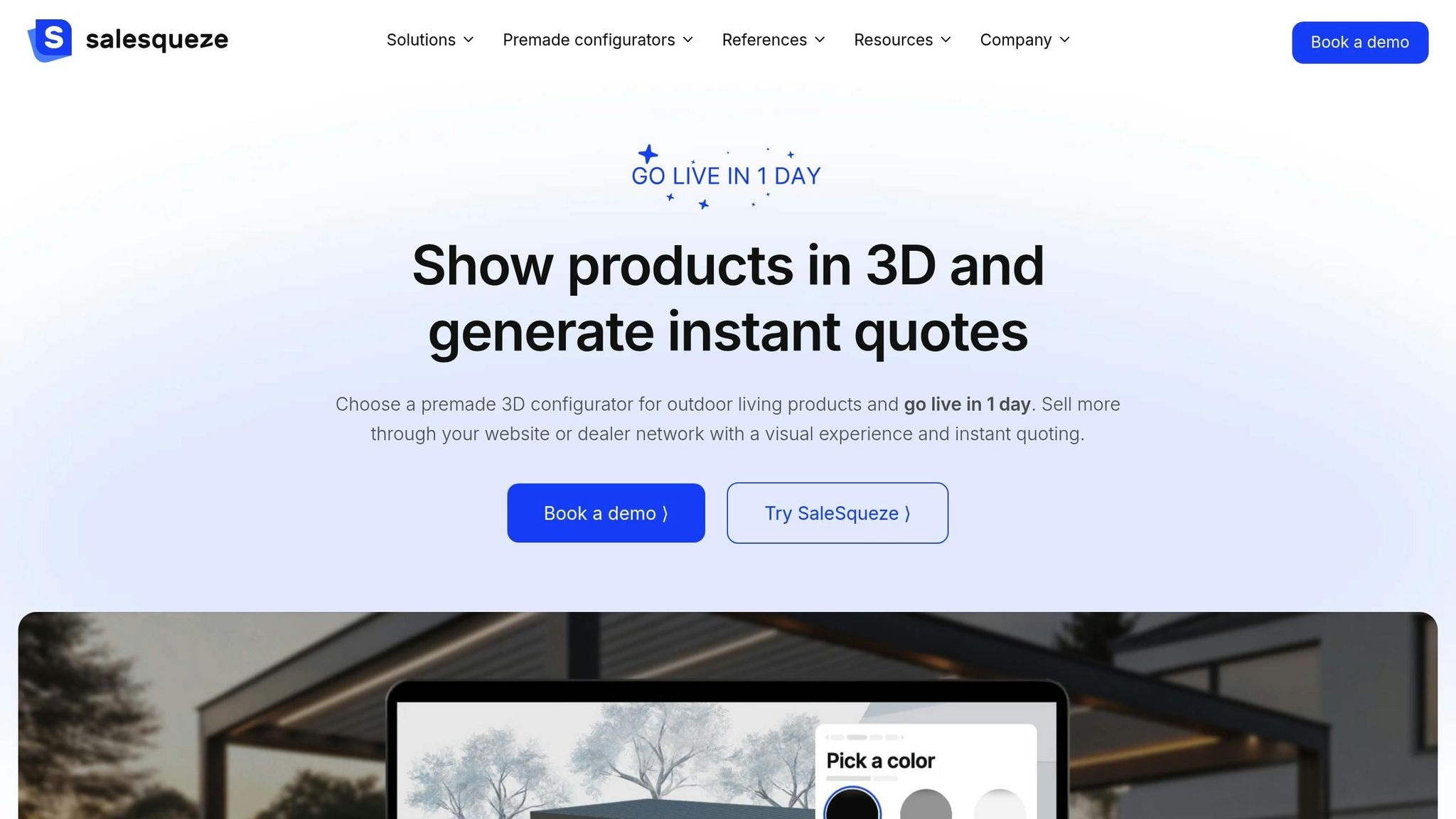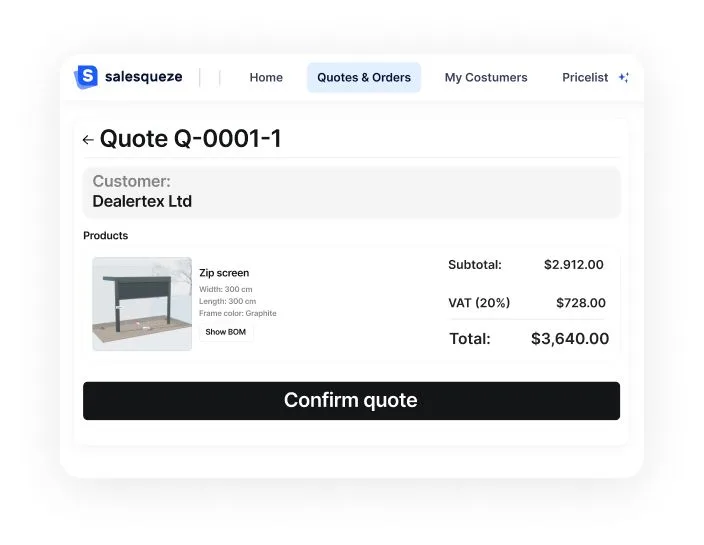3D configurators are transforming how outdoor products like pergolas, glass roofs, and carports are ordered. Traditional methods – relying on emails, phone calls, and paper catalogs – are inefficient, error-prone, and slow, often causing delays and miscommunication. These tools solve these problems by offering real-time visualization, automated pricing, and self-service options, making the process faster and more accurate.
Key Benefits of 3D Configurators:
- Instant Visualization: See precise designs, dimensions, and color combinations in real time.
- Automated Pricing: Quotes are generated instantly, reducing manual errors and saving time.
- Self-Service Access: Contractors and customers can configure products anytime, without waiting for business hours.
- Fewer Errors: Rule-based logic ensures specifications are accurate, minimizing costly mistakes.
- Integrated Systems: Connects directly to sales and CRM tools, improving order management and communication.
Companies using 3D configurators report faster quoting, reduced errors, and increased sales. For example, SaleSqueze clients have seen up to a 478% increase in lead generation and a 40% boost in sales within months. These tools are essential for businesses looking to improve efficiency, reduce costs, and meet modern customer expectations.
The Problem: Manual Order Workflows Create Bottlenecks
Relying on manual workflows is like trying to navigate a maze blindfolded – it slows everything down and adds unnecessary costs. Traditional methods just can’t keep up with the complexity of today’s customizable outdoor products. These inefficiencies ripple through the process, leading to more errors and delays.
Common Errors in Product Specs and Quotes
Imagine trying to order a custom outdoor product using only paper catalogs, sketches, and samples. It’s no surprise that mistakes happen when contractors and dealers rely on vague descriptions instead of precise visuals. Miscommunication becomes almost inevitable, and these errors often go unnoticed until later stages of a project. By then, fixing them means rework, wasted time, and higher expenses.
Slow Communication Delays Custom Orders
Manual workflows don’t just create errors – they also drag out communication. Instead of quick, seamless exchanges, customers, dealers, and manufacturers are stuck in a game of telephone, passing messages back and forth. Without tools that provide instant visual confirmations, clarifications often need to be repeated multiple times, turning simple decisions into drawn-out delays.
Managing Multiple Product Options Is Complex
Customization is great for customers, but it’s a nightmare to manage manually. Think about it – tracking everything from specific dimensions to 200+ RAL colors, fabric patterns, and accessories on spreadsheets or paper forms is a logistical headache.
Without digital tools, comparing product configurations becomes a guessing game. Customers can’t easily visualize how different fabric colors look with various frame finishes or how adjustments to projection lengths might impact the design. This lack of clarity increases the chances of errors and leaves everyone frustrated.
These challenges highlight why digital configurators are no longer optional – they’re essential for streamlining order workflows and reducing costly mistakes.
The Solution: 3D Configurators Streamline Order Workflows
3D configurators are transforming the way outdoor product orders are managed by cutting through inefficiencies and simplifying workflows. These digital tools replace guesswork and back-and-forth communication with precision, speed, and automation, tackling the challenges that often bog down traditional processes.
Clear 3D Views Prevent Mistakes
With real-time 3D visualization, misunderstandings caused by paper catalogs or rough sketches become a thing of the past. Contractors and customers can see exactly how a louvered pergola will look, complete with specific dimensions, color choices, and accessories. This level of detail leaves little room for misinterpretation.
For example, the configurator can demonstrate how a bronze frame pairs with particular fabric colors or how varying projection lengths impact the overall design. This clarity reduces the chances of change orders, minimizes rework, and ensures customers receive exactly what they envisioned.
What sets this apart is the instant feedback. Every adjustment is reflected in real time, eliminating delays and last-minute surprises that often arise in traditional workflows.
Instant Pricing Speeds Up Quotes
Gone are the days of contractors spending hours manually calculating costs. Automated pricing calculations deliver immediate, accurate quotes. Adjust the size of a glass roof, add motorized screens, or modify other features, and the price updates instantly.
This speed is a game-changer in competitive markets where quick responses can make or break a sale. While manual processes might take days to finalize quotes for complex outdoor products, configurators handle this in seconds. They account for every detail, from materials and labor to accessories and regional pricing differences, ensuring error-free quotes.
Additionally, automation guarantees consistent pricing across all sales channels. Whether the quote comes from a contractor, dealer, or direct customer inquiry, the numbers stay accurate and uniform.
Self-Service Setup Gives More Control
With 24/7 accessibility, contractors no longer need to wait for business hours to explore options or make adjustments. They can configure products, test different setups, and generate quotes whenever it suits their schedule.
This self-service approach empowers contractors to take control. They can experiment with various configurations, try out different color schemes, and explore add-ons without needing to coordinate with multiple people. This independence speeds up decision-making and reduces reliance on manual processes.
Customers also benefit from this flexibility. They can review and tweak configurations at their own pace, leading to more confident purchasing decisions and fewer changes after the sale.
Direct Connection to Sales and CRM Systems
3D configurators don’t just simplify the front-end experience; they also integrate seamlessly with backend systems to enhance overall efficiency. By connecting directly with CRM systems, sales dashboards, and inventory management tools, these configurators eliminate the need for manual data entry. Once a configuration is finalized, all order details flow directly into these systems.
This connectivity ensures that sales teams have instant access to critical information like order status, customer preferences, and project timelines. This centralized approach keeps everyone on the same page and streamlines operations.
It also improves customer service. When customers reach out with questions, representatives can quickly pull up details like configuration specifics, pricing history, and order status. This kind of organized, real-time access was nearly impossible with manual workflows, especially for complex custom orders with numerous options and specifications.
Main Benefits of 3D Configurators for Outdoor Products
Switching from manual order processes to 3D configurators brings sweeping improvements across the board. These tools go beyond just saving time – they reshape how businesses operate, serve their customers, and boost revenue. Let’s take a closer look at how 3D configurators outperform traditional methods.
3D Configurators vs. Manual Processes: A Clear Advantage
When comparing 3D configurators to manual workflows, the differences are striking. Businesses using 3D configurators have reported up to 40% higher conversion rates, thanks to the ability for customers to visualize their purchases before committing.
| Metric | Manual Processes | 3D Configurators |
|---|---|---|
| Time to Quote | Hours to days | Minutes |
| Error Rate | High (due to miscommunication or incorrect specs) | Minimal (rule-based logic prevents errors) |
| Engagement Time | Limited interaction | 2x longer engagement time |
| Return Rates | 16–18% average | Up to 50% reduction |
| Conversion Rates | Standard baseline | Up to 40% higher |
The results speak for themselves. For example, Home Depot saw conversion rates jump by as much as 200%, while UK-based furniture retailer DFS experienced a 106% increase in revenue per visit among customers using their 3D configurators. These tools empower customers to explore independently and make confident decisions, all while speeding up the buying process.
Enhancing the Customer Experience with Interactive Tools
Beyond operational improvements, 3D configurators transform the shopping experience by replacing uncertainty with clarity. Shopify found that cart additions increased by 44% when shoppers used 3D configurators, and 80% of buyers reported feeling more confident when they could view products in realistic detail before purchasing.
Interactive 3D displays also build trust and create a more engaging sales experience. Customers spend twice as much time interacting with 3D visuals compared to static images. And because these tools are accessible 24/7, shoppers can explore options on their own schedule – whether during a lunch break, after work, or over the weekend – eliminating the constraints of traditional sales channels.
Driving Sales and Streamlining Efficiency
The benefits of 3D configurators extend to both sales and operational efficiency. By giving customers a clearer understanding of their purchases, return rates – which average 16–18% in eCommerce – can drop by up to 50%. This reduction in returns translates to significant savings in shipping, restocking, and customer support costs.
Automating tasks like generating visuals and spec sheets also lightens the workload for sales teams, speeding up the quoting process. Businesses see better margins, as customers are more inclined to choose premium features when they can see their value upfront. At the same time, support teams handle fewer inquiries about issues like incorrect sizes or finishes.
Additionally, the data collected by 3D configurators offers insights that can guide product development, inventory management, and marketing strategies. It’s no surprise that 70% of contract interior designers report greater loyalty to manufacturers and dealers who provide these advanced tools.
sbb-itb-ec816af
Case Study: How SaleSqueze Delivers Results

The impact of SaleSqueze is evident through real-world successes. Businesses using SaleSqueze’s 3D configurators have streamlined their order processes, leading to noticeable improvements in sales, operational efficiency, and customer satisfaction. These examples highlight how 3D configurators simplify complex ordering systems and support growth in the outdoor living sector.
Tailored Solutions for Outdoor Living Products
SaleSqueze offers a versatile platform designed for precise customization of outdoor living products. It supports a wide range of items, including louvered pergolas, glass roofs, verandas, carports, garden rooms, awnings, motorized screen blinds, hot tubs, pools, outdoor kitchens, windows, and doors.
With its configurators, customers can fine-tune every detail – adjusting dimensions to the inch, selecting materials, exploring color combinations, and adding optional features. This flexibility allows users to visualize their choices in real time, creating a seamless customization experience. The system is compatible with any supplier’s product models and integrates effortlessly into existing websites through simple embed codes.
For instance, Armat saw a 40% increase in carport sales and a 478% boost in lead generation within just three months of adopting SaleSqueze. By enabling customers to experiment with various carport designs and specifications, the platform significantly reduced the need for lengthy back-and-forth communication, speeding up the sales cycle.
In addition to customization, SaleSqueze enhances workflows by automating pricing and sales management.
Streamlined Quotes and Sales Management
SaleSqueze goes beyond visualization by automating the quoting process. Its integrated tools generate accurate, professional quotes based on customer configurations, eliminating manual errors and cutting down on the time required to prepare quotes.
For example, Impol Servis experienced a dramatic improvement in efficiency, managing 14 times more inquiries and reducing quote preparation time from 40 minutes to just 5. The automated system not only saved time but also ensured consistent accuracy across all quotes.
The platform’s sales dashboard offers real-time insights into lead activity, quote progression, and conversion rates. Sales teams can monitor customer interactions with specific configurations, identify high-priority leads, and tailor their follow-ups to match customer behavior. These features help businesses focus their efforts where they matter most, driving tangible results.
Real-World Success Stories
The measurable outcomes achieved by businesses using SaleSqueze are impressive. A modular house seller generated $10 million in quotes within a single month using the platform’s Visual CPQ system. Over a 30-month period, a modular houses manufacturer secured $133 million in leads after digitizing its sales process with SaleSqueze.
Similarly, Spa Solutions achieved a 17% sales conversion rate with a 3D pergola configurator over just 90 days, far exceeding industry averages in the outdoor living market. A blinds manufacturer also saw remarkable results, generating 380% more quotes, showcasing how a self-service approach can significantly enhance lead generation without requiring additional sales staff.
These examples highlight the transformative effects of faster quoting, fewer errors, and increased customer confidence through interactive 3D visualization. Many businesses report seeing improvements in just the first month of implementation, with benefits compounding as customers become more comfortable with the self-service configuration tools.
Conclusion: Using 3D Configurators for Better Business
3D configurators are changing the way outdoor living products are sold. By simplifying workflows, cutting down on manual quoting, and reducing communication gaps, these tools make order processing faster and more accurate. With customers able to visually configure products themselves, businesses can handle orders with greater precision.
For example, companies using SaleSqueze report generating quotes 70% faster and handling inquiries 14 times more efficiently. Lead generation has seen increases as high as 486%, showcasing the platform’s impact on overall performance.
These tools deliver clear advantages across a wide range of outdoor products, from carports and pergolas to garden rooms. The combination of instant visualizations, automated pricing, and smoother workflows leads to noticeable growth. Many businesses experience these benefits almost immediately after adopting the technology.
The outdoor living industry is moving toward a customer-first approach, where buyers expect to see their choices in real time, tweak specifications as needed, and receive professional quotes without delays. 3D configurators not only meet these demands but also address long-standing operational challenges in custom product sales. This shift in expectations calls for quick action, and SaleSqueze offers a solution that can be implemented in just one day.
For contractors and dealers, adopting this technology is no longer optional. It’s the key to capturing more leads, closing more sales, and building stronger customer relationships. The businesses that embrace faster, more accurate, and engaging ordering experiences will gain a decisive edge over their competitors.
The future of outdoor living sales lies in visual, interactive, and customer-driven experiences. 3D configurators are setting a new standard, making the buying process faster, more engaging, and tailored to modern customer expectations.
FAQs
How do 3D configurators make ordering custom outdoor products easier and more accurate?
3D configurators make ordering custom outdoor products easier and more precise by providing real-time, interactive visualizations. They allow customers to watch their designs take shape, tweak details as needed, and confirm everything before finalizing their order. This helps avoid mistakes that often stem from unclear communication or misunderstood specifications.
On top of that, these tools automatically produce accurate specifications and measurements for the chosen design. This ensures consistency during production, minimizes errors, and results in a seamless ordering experience. The final product ends up matching the customer’s expectations perfectly.
How do 3D configurators make ordering easier and more efficient?
3D configurators make ordering easier by letting customers see and customize products in real-time, which helps eliminate confusion and mistakes. This hands-on approach gives customers more confidence in their decisions and ensures orders are correct right from the beginning.
These tools also simplify workflows by automating tasks such as creating specifications and generating quotes. This not only speeds up decision-making but also accelerates order processing. The outcome? A quicker, more seamless process that boosts customer satisfaction while improving overall business operations.
How do 3D configurators work with sales and CRM systems to improve efficiency?
3D configurators integrate effortlessly with sales and CRM systems using APIs and built-in tools. This connection allows for real-time updates on customer information, product configurations, and pricing, cutting down on manual work and lowering the risk of mistakes.
By streamlining tasks like generating quotes and tracking orders, these tools enable sales teams to respond with greater speed and precision. This leads to a more efficient workflow, boosts productivity, and enhances the overall experience for customers.

